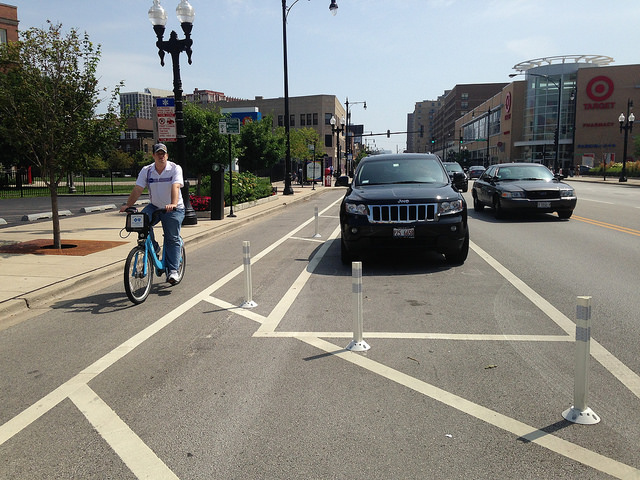Broadway Protected Bike Lane Named Among Nation's Best
By Chuck Sudo in News on Dec 18, 2014 4:35PM
Protected bike lanes such as the ones on Kinzie, Dearborn and Milwaukee have done wonders in making hectic stretches of roadway in Chicago safer for bicyclists, pedestrians and even motorists simply by their design. What once were open stretches of streets where drivers would speed like their hatchbacks were funny cars have instead become calm roadways where motorists and bicyclists can share the street with a modicum of security.
Last year the advocacy group People for Bikes named the Dearborn Street protected bike lane the best in America, and stats from the Chicago Department of Transportation show cyclists are actually responding to the dedicated stop lights on the lane. (I’ve found the same to be true when using the Milwaukee Avenue protected bike lanes.)
People for Bikes named its 2014 list of the best bike lanes in the country and the new buffered/protected lanes on Broadway in Uptown closes the list at number 10. The Green Lane Project’s Michael Andersen said the lanes, which run through the heart of Uptown’s commercial district, is further proof of the country embracing cycling by “turn(ing) solid projects like these into standard operating procedure.”
The bike lanes have transformed Broadway from Montrose to Foster from four lanes to two, and added additional turn lanes. Streetsblog Chicago’s John Greenfield notes the design has “transformed a hectic, dangerous stretch of Broadway into one that’s calmer and safer for pedestrians and drivers, as well as cyclists.” (Greenfield also observed the plastic posts separating the bike lanes from the parking lane have disappeared recently. Normally these posts are victims to snow plows and drunk drivers; these ones were lifted from the street completely.)
Transit advocate Shaun Jacobsen observed the lanes still need some work. They disappear completely at intersections and there was no green paint used to designate the lanes for bikes, ostensibly because there were no funds available. “If there were more funds available (and there are, somewhere),” Jacobsen writes, “the striped areas could have been bioswales with trees or other traffic-calming, protective infrastructure.”
Compared to what biking that stretch of Broadway used to be, this is still progress.
